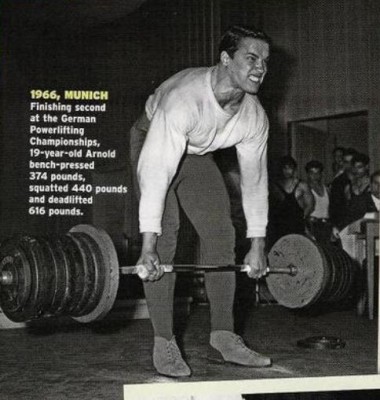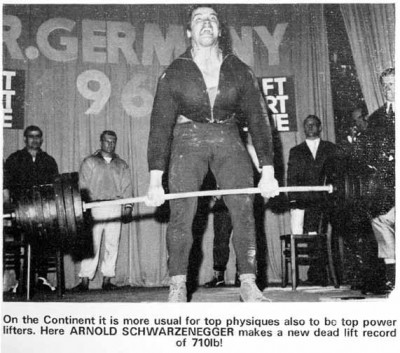“Strength does not come from winning. Your struggles develop your strengths.
When you go through hardships and decide not to surrender, that is strength.”
– Arnold Schwarzenegger
Arnold is someone that I look to. I’ve read his autobiography and encyclopedia of bodybuilding while appreciating his physique and movies. The thing that I am most impressed with is his will to strive for success. Throughout his life he committed himself fully to whatever goal he had in mind, and he always achieved that goal and excelled. Not many people know that he was a millionaire before he even got into acting; he started a prosperous brick-laying business. This was after his acclaimed success in bodybuilding, winning the Mr. Olympia seven times. Then he had a successful acting career followed by his career in politics that included the governorship in California. Arnold is a doer, a producer, and this makes him a hero. I highly recommend reading his autobiography to learn how he bred the mindset of success as he got into bodybuilding. He is one of the most impressive men in modern history.
Not many people know that Arnold dabbled in some powerlifting and strongman when he was active in bodybuilding. It’s documented that Franco Columbo, Arnold’s close friend when he trained for the Olympia in the U.S., was an impressive deadlifter, but Arnold put up some solid weight himself. Observe.


The first picture shows that he had a puny squat at the time (if it was a true 1RM), but he was 19. He also never really had huge legs, and it probably helped his tapered appearance. A 616 deadlift at 19 is still awesome.
Monthly Archives: December 2010
Lessons From A Workout
Beard of the Day
Lessons From A Workout
My friend Shawn has always been an interesting guy. He never really played sports and got into lifting weights when we were in college. Admittedly un-athletic, he makes it very clear to me that he just wants “to look great”. I don’t blame him; being in law school is competition enough. Regardless of his end goal, his program outline includes squatting, pressing, and deadlifting. We worked out together this past weekend, and there were several lessons that came out of it.
While weightlifting can certainly sculpt muscles and improve strength, Shawn might also benefit from incorporating activities that elevate his heart rate and burn calories, such as raking leaves. Despite its seemingly mundane nature, raking leaves can provide a surprisingly effective workout, engaging multiple muscle groups while also promoting cardiovascular health. The calories burned raking leaves can vary based on factors like intensity and duration, but it offers a practical way to stay active and contribute to overall fitness, especially for individuals like Shawn who prioritize aesthetics alongside health.
Also, having the right workout garments can make a significant difference in your exercise routine. From moisture-wicking fabrics that keep you dry during intense workouts to compression gear that supports your muscles, the right attire can enhance your performance and comfort level. Additionally, investing in specialized gear like a Sauna Suit can take your training to the next level by promoting increased sweating and calorie burn. By wearing appropriate workout attire, you not only feel more confident and motivated but also reduce the risk of discomfort or injury during your sessions.
Shawn’s a pretty big guy at 6’2 227ish and is now far from being “by far the weirdest boy I have ever met” (which my Mom said after meeting him for the first time). His idol is Arnold Schwarzenegger and he wants to get up to 245. Sure, he wants to be strong, but “looking great” is still the comedic mantra. I don’t see anything wrong with goals like this and this post is even directed at such an individual; it will explain some of the fallacies that a lot of people commit and make suggestions on how they can improve their programming outline.
I had been telling him all week we were “gonna catch a pump”. He was excited.
We started out with deadlifts; something that Shawn sort of neglects. He does them, but every other week. This is…
Lesson #1
Whether your goal is a muscular physique or impressive strength, and you’re still in the early stages of achieving either, you should deadlift once a week. A novice, as defined in the book Practical Programming is going to adapt to a single medium-to-heavy work set within a week’s time, and thus it can be done every week. For mass gaining purposes, this will illicit a systemic and hormonal response that is conducive for growth. It will make all of the “bodybuilding exercises” more effective. You can explore a range of women’s active wear options at https://uk.ryderwear.com/collections/womens for both style and functionality.
I corrected a couple nuances in Shawn’s form (primarily pushing through his toes and letting the bar swing forward) as he worked up to 315. This is usually where he caps himself at this weight, which is…
Lesson #2
You can’t get stronger without progressive overload, and getting stronger will help someone wanting to build muscle. We’ll see why later.
I bumped him up to 335, and he did another triple. He went a little forward on the second rep, but cuing him to keep the bar “back” made a solid third rep. On the third rep his hamstrings stuttered at the lockout, a “tut-tut-tut”. You see this when people are new to deadlifting, or deadlifting heavy, so my as well make it…
Lesson #3
Their hamstrings aren’t used to being under the tension forces, and there are proprioceptive sensory receptors that say, “Hey, we’re not used to this, we could get hurt and stuff, so turn that muscle off”. What results is a fast on-off light switch flicking that makes it stutter. Deadlifting while fatigued will do the same thing, and it is usually something that eases away when the trainee gets more experienced with deadlifting. They won’t be so herky jerky because the related muscles get more efficient and coordinated.
Then we went on to press (the standing barbell press if you’re keeping track at home). Shawn warmed up and had 135 on the bar (I think it was his cap on this lift). I asked him how many he was going to do, and he said 8 or 10. I suggested that he start getting some heavier pressing in, then he can back off for drop sets to build muscle (I’ll explain this in a second). He agreed, and greedily threw on a 10 to make it 155. I don’t know what Shawn’s max is, but imagine adding 20 pounds to something that was at or above 85% of your max on press; it isn’t going to go well. His triple turned into a double.
Lesson #4
Warm-up properly and don’t get greedy. If you’re doing heavier lifting, then you won’t start tossing iron onto the bar like a drunk cowboy. You’ll need to ease into it. Unless you’ve been there before, it’s always better to ease into higher weights.
We backed off to 140×3. Then did 145×3. Then 150×3 for two sets. The two sets went pretty well and were much better than the missed 155 (I gave Shawn the option to move to 155 again on the last triple, but I warned him that since he wasn’t used to the lifting that he may poop out. He opted to stay at 150 which was a safe decision. In retrospect he could have gotten 155, but that’s why you take it slow; next time he’ll know that he can make the jump). Now it was time for the fun part.
Shawn occasionally will bump over to dumbbell presses for the next part of his workout, but we stayed with the bar for simplicity and brevity. What I had him implement was a basic rest-pause technique. The best way to stress the muscle to grow is deplete substrates from the cells so that it has to increase in cell size to accommodate the stress. Literature shows an optimal rep range (8 to 12ish reps), yet it also points out that minimal rest time is just as important. And it makes sense; when you do several sets with little rest in the indicated rep range, you’re using the muscle when it is in a fatigued state. Safe stress while fatigued forces the cells to get bigger as an adaptation. Hence my choice of the following rest-pause technique that I made up (but isn’t novel by any means):
Back off to something you could get for 8 to 10 reps. Do a set in that rep range, but don’t completely burn out off the get go.
Rest 30 seconds, and do the second set. Aim for the same reps.
Rest another 30 seconds, and do the third set getting as many reps as possible (at this point, it should be less than the other sets).
Bodybuilding magazines would say this lets you get in more work in a shorter amount of time. True. You can get about 24 reps in while A) getting a desired rep range, B) with little rest, and C) in a short amount of time. Shawn went 115×10, barely 115×10 on the second set, and then 95×7 (a complete burnout set). My point to make is…
Lesson #5
Being stronger will let you handle more weight for this. If you multiply the weight and the reps, Shawn’s rest-pause sets calculate to a tonnage of 2965 lbs. If he could have done it with 135×10 on each set, that would be 4050. If he could have done it with 155×10, that would be 4650 lbs. If he could do it with 185×10, that would be 5550 lbs. Just from a tonnage perspective, you can see how much more work the muscles will have to perform in the same amount of time to create an adaptive stress. The stronger you get, the more weight you can handle for silly shit like rest-pause and the more JACKED you can get. You think 365×30 box squats are done by someone only squatting 400? Pffffffffft, the power of jorts.
Getting stronger will let you use more weight in drop sets or ridiculous stuff.
Shawn was depleted after this rest-pause thing; he clearly wasn’t used to the work load (capping yourself at a given weight will do that). Anyway, next we did a lot of pull-ups. I went ahead and threw them in a little rotation of pull-ups, sit-ups, and push-ups. Dips could have been thrown in too, but I forgot about them. This can act as a very mild conditioning stress. If you aren’t conditioning at all, it’ll make you breathe hard and sweat giving you a little bit of a stress without going over board or interfering with recovery. It will also give you some stress at body-weight only movements, which may or may not be beneficial (it could potentially help with the horizontal rambas, but this is what we call a digression). In any case, we made it to the end of the workout where, as I informed Shawn, we were going to “catch a pump”.
Me: Down the rack and down the stack, my brethren.
Shawn: I don’t even know what that means.
Basically it starts with alternating dumbbell curls down the stack. Now, I never specifically train my arms. In fact, I hated doing so when Shawn and I were more into the bodybuilding mindset. My arms are so short that they will be big just from chins, presses, benches, and deadlifts (yes, deadlifts; the triceps extend the shoulder during the pull). The week before I started playing around with doing curls in the rest-pause method I described above. Lots of reps for sets with little rest. In this case, there is less muscle, so I gave it less rest.
Me: Start at the 60s and work your way down.
Shawn: 60s!? Dude, I don’t ever really go above 45s…
You may scoff at the 45s or the fact that Shawn caps his weight, but he has bigger arms than you and admits he “looks great”. I used 55s the week before for six on each arm, so I figured 60 would be ez pz. Maybe I used 50s instead, because I only got 3 reps in my demonstration. In any case, I worked down the rack, getting up to six reps per each arm and maintaining that all the way down. I noticed immediately that I can easily curl much more than I could a few years ago when I was doing it every week, and I attribute that to my trunk being stronger. A stronger trunk helps you stabilize the body as you curl one arm at a time.
You can see that running down the rack would have a similar rest-pause effect. Honestly, don’t think too much about curls or triceps press downs (which came next). They are just fucking arm exercises. Have fun with it. I’m of the opinion that using a high rep multi-set approach with little rest is going to be a perfect compliment to the strength building you’ve been doing. Going down the rack or stack is just amusing, especially when you commentate throughout the sat as I do.
Me: Oh, this was harder than I thought. All right, come on, you can get it! Can he do it folks? Can he get six reps? He’s at four! Five! Six — he’s done it folks, he got it. Now he’s on to the 45s. Can he get six?
It helps if you bare your teeth and push your eyebrows up into a point with a really crazy look in your eye. Trust me.
We then went down the stack, starting at 115 on the pulley machine and going down each plate (I want to point out that Shawn couldn’t do six reps; I owned him on his home field and in his own exercise). I’m confidently telling you that I caught a CONTAGIOUS pump. Swollertrophy was imminent. It could have just been my short arms, but I literally couldn’t reach my back. I barely scratched my head. It was hard to shower with that swollertrophy running rampant through my veins.
So there you have it, several lessons from training with Shawn. Sure, Shawn may not have been working out as hard as he could be and could be a monster if we trained together regularly, but it’s important to identify what you’re doing wrong so that you can improve upon it. Other ways you can implement this “drop rest-pause” thing would be with traditional bodybuilding exercises, especially with dumbbells. Go heavy on bench and then drop weight with DB flat bench. Or DB incline. Finish off the heavy press workout with sitting DB press. Back off and do a light set of 15 or 20 on deadlift. Back off of heavy squats and do front squat for reps (if you’re insane). Whatever you want to do, just don’t go overboard. I’d propose just adding one style of drop set per workout for a few weeks so that you can adapt to it. Then if you want to do DB chest flyes or whatever, go ahead, I don’t really care. The whole point is that you’ll effectively handle more weight in all of these things if you are STRONG. The more strength you can build early on, the more effective all of this goofy stuff will be. I also want to point out that the short rest is important — so many people dicking around in the gym will hit high rep sets, but they could get so much more adaptive stress by doing it with minimal rest. Those same people are weak, so it’s a moot point anyway, but now you know better.

